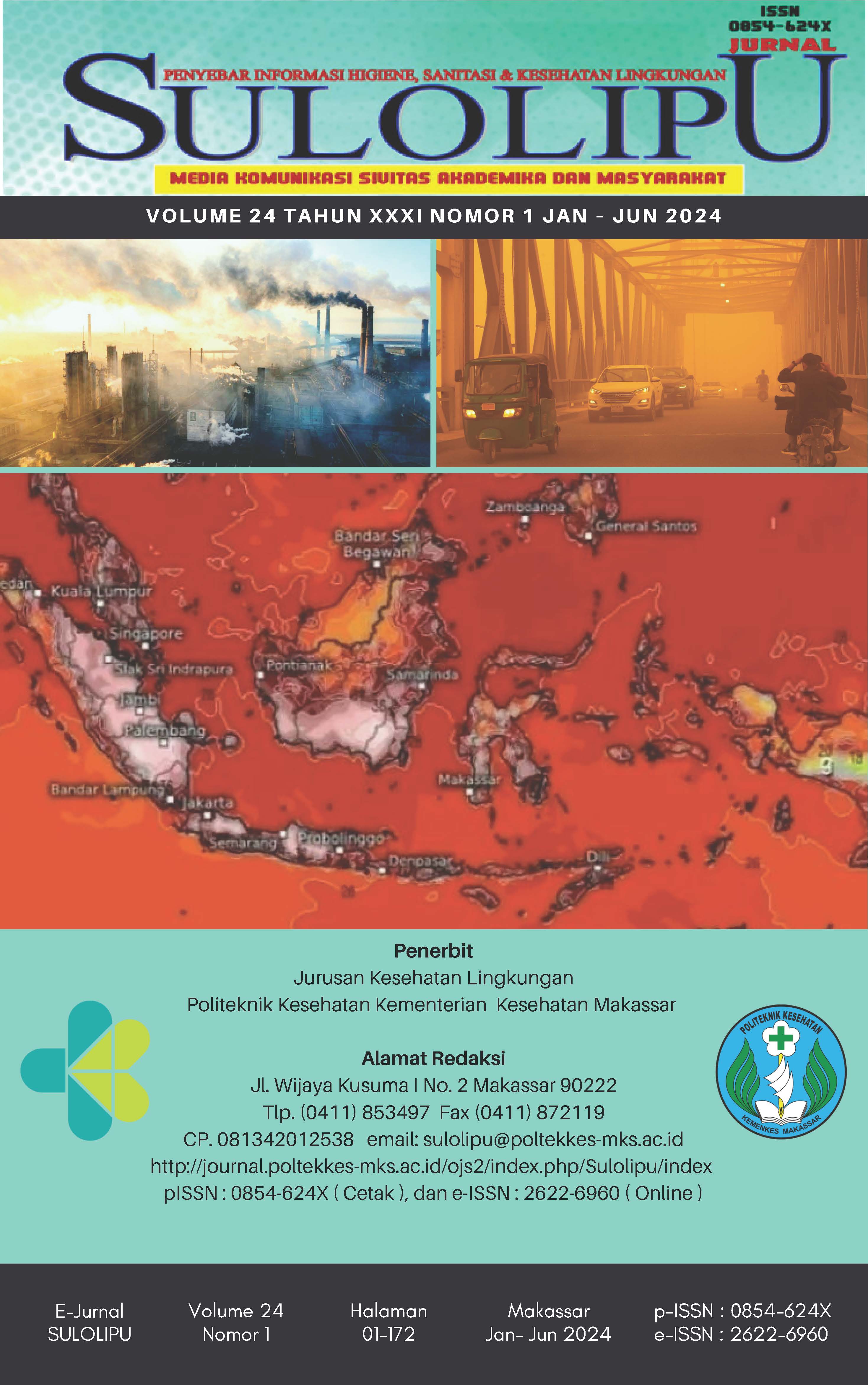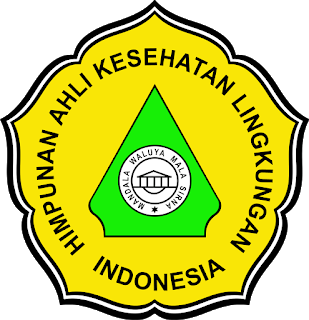The Ability of the Combination Method of Tamarind Seed Coagulation and Mangrove Root Filtration in Reducing Turbidity and Chloride (Cl) Levels in Dug Well Water in Coastal Areas
DOI:
https://doi.org/10.32382/sulo.v24i1.466Keywords:
Air Bersih, Biji Asam Jawa, Akar Mangrove, Kekeruhan, KloridaAbstract
Clean water is a source of life for everyone, so its preservation and existence must be maintained as much as possible both in quantity and quality. Tamarind seeds (Tamarindus Indica L) can be used as an alternative coagulant to replace alum because it is more environmentally friendly. Mangrove roots are said to be able to reduce chloride levels because basically, like the roots of other higher plants, mangrove roots play a selective role in absorbing ions, which are carried and transported to the xylem. This study aims to determine the ability of a combination method of tamarind seed coagulation and mangrove root filtration in reducing turbidity and chloride (Cl) levels in dug well water in coastal areas. This type of research is quasi-experimental with coagulation and filtration methods. The results showed that in the initial sample the water turbidity was 76.9 NTU and the chloride content was 60,481.2 mg/l after processing using tamarind seeds, the turbidity reduction was 82.93% and the chloride level was 71.06%. Processing using mangrove roots resulted in a decrease in turbidity of 90.19% and chloride content of 90.51%. Meanwhile, the combination processing using tamarind seeds and mangrove roots resulted in a decrease in turbidity of 94.77% and chloride content of 96%. From the results of this study it can be concluded that the use of tamarind seeds and mangrove roots can reduce turbidity (NTU) and chloride (Cl) levels in dug well water in coastal areas with the ability to reduce turbidity by 94.77% and reduce chloride levels by 96%. The community can utilize tamarind seeds and mangrove roots in simple water treatment.
Keywords : Clean Water; Tamarind Seed; Mangrove Roots
References
Darmawansa, Wahyuni, N., & Jati, D. R. (2014). Desalinasi Air Payau Dengan Media Adsorben Zeolit Di Daerah Pesisir Pantai Kecamatan Sungai Kunyit Kabupaten Mempawah. Jurnal Teknik Lingkungan 1–10. Pontianak.
Fauzan, nurhdy muhammad R. djamaluddin, & Suparmin. (2022). Pengaruh Ketebalan Media Filtrasi Sebagai Pengolahan Air Terhadap Kekeruhan dan Bau Sumur Gali di Desa Kragilan Kecamatan Kragilan Kabupaten Serang Tahun 2022 Effect of Thickness of Filtration Media as Water Treatment on Turbidity and Smell of. Buleting Kesehatan Lingkungan Masyarakat, 41(3), 137–143. https://ejournal.poltekkes-smg.ac.id/ojs/index.php/keslingmas/article/view/8812/pdf
Hakim, D. L. (2010). Aksesibilitas Air Bersih Bagi Masyarakat Di Permukiman Linduk Kecamatan Pontang Kabupaten Serang [UNIVERSITAS DIPONEGORO SEMARANG]. (Online). http://eprints.undip.ac.id/23686/1/DIDIN_LUKMANUL_HAKIM.pdf
Hendrawati, Syamsumarsih, D., & Nurhasni. (2013). Penggunaan Biji Asam Jawa (Tamarindus indica L.) dan Biji Kecipir (Psophocarpus tetragonolobus L.) Sebagai Koagulan Alami Dalam Perbaikan Kualitas Air Tanah. 3(1), 357–370. https://media.neliti.com/media/publications/108081-ID-penggunaan-biji-asam-jawa-tamarindus-ind.pdf
Hernaningsih, T., & Yudo, S. (2007). Alternatif Teknologi Pengolahan Air Untuk Memenuhi Kebutuhan Air Bersih Di Daerah Permukiman Nelayan. Jurnal Air Indonesia, 3(1), 38–49. Jakarta.
Kartika, D., Nurjazuli, & Budiyono. (2016). Kemampuan Serbuk Biji Asam Jawa Dalam Menurunkan TSS, Turbiditas, Dan Amoniak Pengolahan Limbah Cair PT. Utama Multiniaga Indonesia. Kesehatan Masyarakat, 4(4), 917–924. (Online). http://ejournal-s1.undip.ac.id/index.php/jkm
Mbusa, H. T. P. (2020). Manajemen Pelayanan Air Bersih Di Desa Maropokot Kecamatan Aesesa Kabupaten Nagekeo Provinsi Nusa Tenggara Timur. (Online). https://doi.org/10.1088/1751-8113/44/8/085201
Nurhidayanti, N., Ilyas, N. I., & Lazuardini, D. P. (2022). Studi Pengolahan Limbah Cair Laundry menggunakan Serbuk Biji Asam Jawa sebagai Biokoagulan. Jurnal Tekno Insentif, 16(1), 16–27. https://doi.org/10.36787/jti.v16i1.453
Onrizal. (2005). Adaptasi Tumbuhan Mangrove Pada Lingkungan Salin Dan Jenuh Air. Jurnal Pertanian, 1–15. Sumatera Utara.
Pawestri, A., Widiyanto, T., & IW, H. R. (2018). Pengaruh Penggunaan Serbuk Biji Asam Jawa (Tamarindus indica L) Sabagai Koagulan Dalam Menurunkan Air Baku di PDAM Tirta Wijaya Cilacap Tahun 2018. Global Health Science, 1–10. Semarang.
Prabowo, Bambang Hari., Zahra Nursaidah., Febby Safitri. (2019). Pengaruh H2O2 dalam Metode Koagulasi Pengolahan Air Payau Menggunakan Koagulan PAC dan Aluminium Sulfat. Jurnal Teknik: Media Pengembangan Ilmu dan Aplikasi Teknik, Vol 18, No 2. (Online). http://jurnalteknik.unjani.ac.id/index.php/jt
Radhika, Firmansyah, R., & Hatmoko, W. (2017). Perhitungan Ketersediaan Air Permukaan Di Indonesia Berdasarkan Data Satelit. Jurnal Sumber Daya Air, 13(2), 115–130. (Online). https://doi.org/10.32679/jsda.v13i2.206
Wahyuni, N., Sasri, R., Rudiyansyah, R., Usman, T., & Utomo, K. P. (2020). Pengolahan Air Bersih Menggunakan Bahan Baku Lokal Untuk Daerah Pesisir Terpencil Di Kabupaten Kubu Raya. GERVASI: Jurnal Pengabdian Kepada Masyarakat, 4(2), 192–199. https://doi.org/10.31571/gervasi.v4i2.1836
Downloads
Published
How to Cite
Issue
Section
PDF (Bahasa Indonesia) downloaded: 310



















